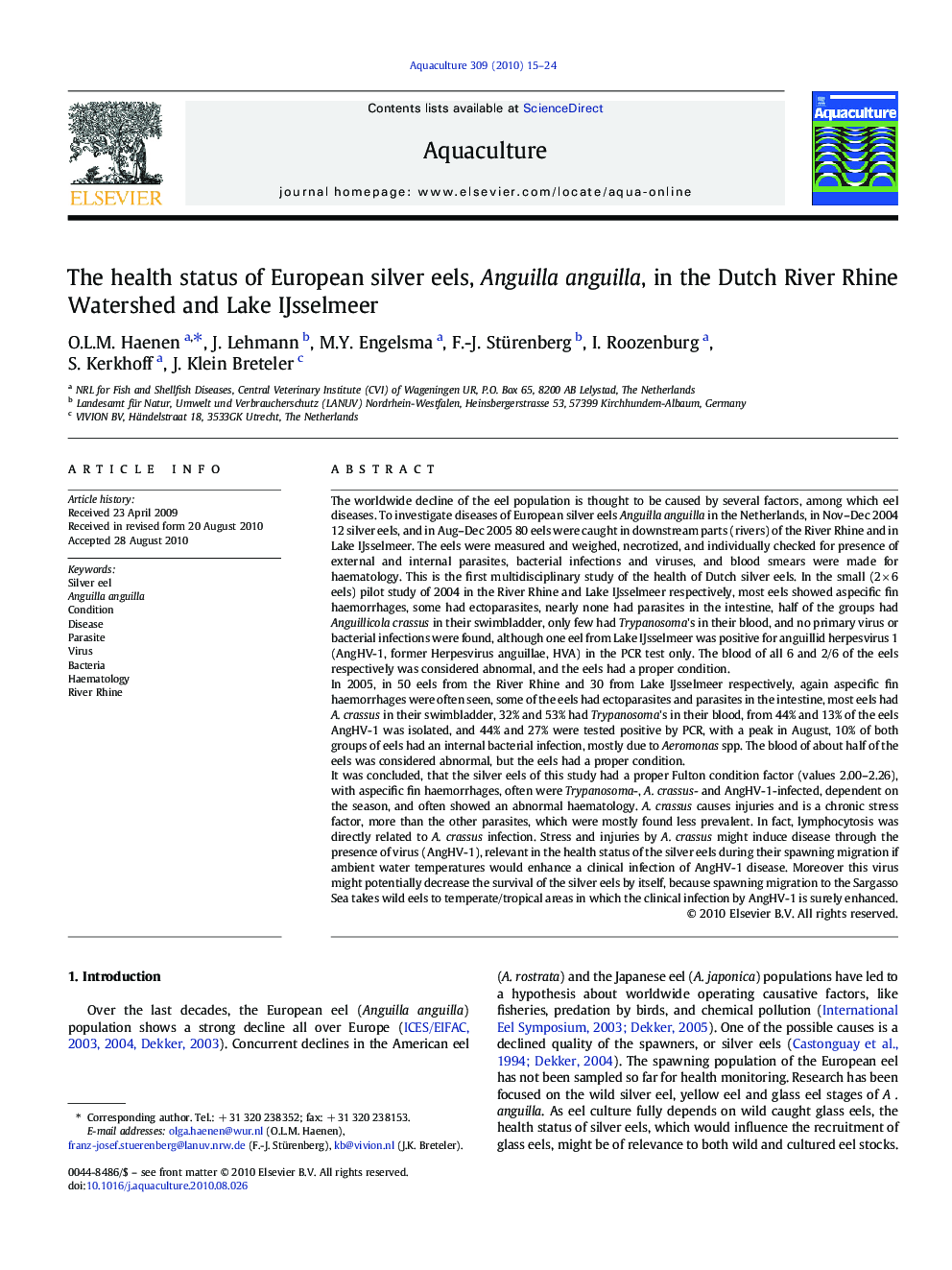| کد مقاله | کد نشریه | سال انتشار | مقاله انگلیسی | نسخه تمام متن |
|---|---|---|---|---|
| 2423479 | 1552917 | 2010 | 10 صفحه PDF | دانلود رایگان |

The worldwide decline of the eel population is thought to be caused by several factors, among which eel diseases. To investigate diseases of European silver eels Anguilla anguilla in the Netherlands, in Nov–Dec 2004 12 silver eels, and in Aug–Dec 2005 80 eels were caught in downstream parts (rivers) of the River Rhine and in Lake IJsselmeer. The eels were measured and weighed, necrotized, and individually checked for presence of external and internal parasites, bacterial infections and viruses, and blood smears were made for haematology. This is the first multidisciplinary study of the health of Dutch silver eels. In the small (2 × 6 eels) pilot study of 2004 in the River Rhine and Lake IJsselmeer respectively, most eels showed aspecific fin haemorrhages, some had ectoparasites, nearly none had parasites in the intestine, half of the groups had Anguillicola crassus in their swimbladder, only few had Trypanosoma's in their blood, and no primary virus or bacterial infections were found, although one eel from Lake IJsselmeer was positive for anguillid herpesvirus 1 (AngHV-1, former Herpesvirus anguillae, HVA) in the PCR test only. The blood of all 6 and 2/6 of the eels respectively was considered abnormal, and the eels had a proper condition.In 2005, in 50 eels from the River Rhine and 30 from Lake IJsselmeer respectively, again aspecific fin haemorrhages were often seen, some of the eels had ectoparasites and parasites in the intestine, most eels had A. crassus in their swimbladder, 32% and 53% had Trypanosoma's in their blood, from 44% and 13% of the eels AngHV-1 was isolated, and 44% and 27% were tested positive by PCR, with a peak in August, 10% of both groups of eels had an internal bacterial infection, mostly due to Aeromonas spp. The blood of about half of the eels was considered abnormal, but the eels had a proper condition.It was concluded, that the silver eels of this study had a proper Fulton condition factor (values 2.00–2.26), with aspecific fin haemorrhages, often were Trypanosoma-, A. crassus- and AngHV-1-infected, dependent on the season, and often showed an abnormal haematology. A. crassus causes injuries and is a chronic stress factor, more than the other parasites, which were mostly found less prevalent. In fact, lymphocytosis was directly related to A. crassus infection. Stress and injuries by A. crassus might induce disease through the presence of virus (AngHV-1), relevant in the health status of the silver eels during their spawning migration if ambient water temperatures would enhance a clinical infection of AngHV-1 disease. Moreover this virus might potentially decrease the survival of the silver eels by itself, because spawning migration to the Sargasso Sea takes wild eels to temperate/tropical areas in which the clinical infection by AngHV-1 is surely enhanced.
Journal: Aquaculture - Volume 309, Issues 1–4, 22 November 2010, Pages 15–24